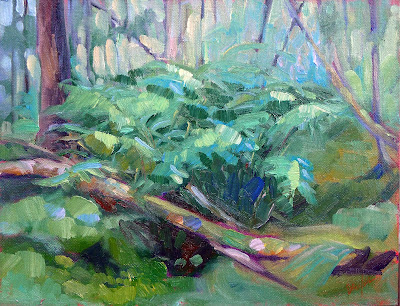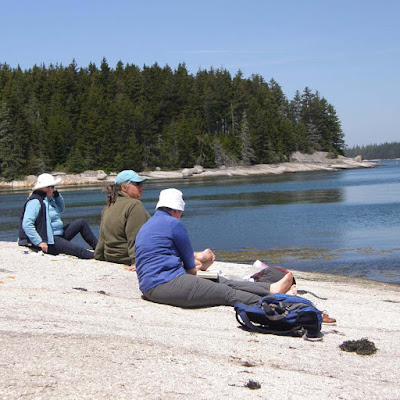COVID didn’t cause the supply-chain problems we’re experiencing—it exposed them. Hopefully, we’ll solve them before another, bigger disruptor comes our way.
 |
| Main Street, Owls Head, oil on gessoboard, 16X20, $1623 unframed. |
Early this month my laptop suffered a catastrophic failure. This is not the fault of Dell; I’d poured molten wax and water into it during a Zoom class in the winter. It had been wonky ever since. In fact, it had limped nobly on for longer than could be reasonably expected.
I called my programmer daughter for advice because my programmer husband is sick to death of fixing my stuff. Through the miracle of modern electronics, we had two calls going for a while.
“He’ll say, ‘she needs one built like a tank,’” I told her, just as I heard him yell, “She needs one built like a tank!” To be fair, that hasn’t actually worked. I once bought a hardened-case, ‘rugged’ specialty laptop. It didn’t last any longer than any other laptop.
 |
| Bracken Fern, oil on canvasboard, 9X12, $869 framed. |
My daughter has had a Lenovo ThinkPad for four years. It’s doing fine, so we settled on the configuration I needed and placed an order. As you can imagine, one of the critical requirements is that I could actually get the darn thing.
And, of course, I can’t. Every day, its delivery date is pushed back another two days. There is a global semiconductor shortage. Of course, we’re blaming it on COVID, when the real issue is a supply-chain problem that COVID exposed.
 |
| Nighttime at Clam Cove, oil on canvasboard, $869 framed. |
My workshopsare experiencing a related problem. Students report that they can’t get rental cars in their destinations. Yesterday, visitors to my gallery told me that they couldn’t find a rental car in Portland; they had to fly into Boston instead. Rental-car companies sold much of their fleets in the pandemic. Now there’s a shortage of rental cars just as Americans are jonesing to get on the road. The car-rental companies can’t buy replacements because of the aforementioned semiconductor shortage. It’s estimated that this will cut worldwide auto production by more than a million vehicles in 2021.
So, we understand: we must wait patiently for anything that has a chip in it.
Last month the bottom of our garage door crumbled off. It’s far past repair; it’s a heavy, wonky, old thing from the 1940s. I ordered replacement doors from Home Depot because I find them reliable, and you can’t even get a contractor to return your calls in today’s market. Yesterday, I got a notice from their home office—the door will be here in mid-November.
 |
| Apple Tree Swing, oil on canvasboard, 16X20, $1623 unframed |
That’s been the case with every major purchase we’ve tried to make this year. There’s no inventory, and even things made within the US have a six-month lead time. If these supply-chain disruptions are impacting my business, they’re impacting every business in America.
Of course, COVID didn’t cause the supply-chain problems we’re experiencing—it exposed them. Hopefully, we’ll solve them before another, bigger disruptor comes our way.
So far, we haven’t experienced supply-chain problems in paint or canvases (although there are no manufacturers of pigments within the United States). Therein lies an opportunity.
People generally look at paintings in terms of their own enjoyment, but fine art is also an investment. The art market is fickle, and there are no guarantees of profitability, but with a little critical thinking, you can fill your home with beauty that can appreciate over time.
































